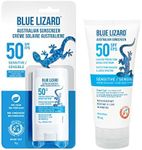Buying Guide for the Best Baby Sunscreen Stick
Choosing the right baby sunscreen stick is important to protect your child's delicate skin from the sun's harmful rays. Since babies have more sensitive skin than adults, it's essential to look for products that are gentle, effective, and easy to apply. When shopping for a baby sunscreen stick, focus on the ingredients, level of sun protection, ease of use, and how well it suits your baby's skin type and activities. Understanding the key features will help you make a safe and comfortable choice for your little one.SPF RatingSPF stands for Sun Protection Factor, and it measures how well the sunscreen protects against UVB rays, which are the main cause of sunburn. For babies, a higher SPF is generally better, with SPF 30 to 50 being the most common range. SPF 30 blocks about 97% of UVB rays, while SPF 50 blocks about 98%. If your baby will be outside for extended periods or has very fair skin, a higher SPF is a safer choice. For short outings or if your baby has darker skin, SPF 30 may be sufficient. Always reapply as directed, regardless of the SPF.
Active IngredientsThe active ingredients in sunscreen are what provide the sun protection. For babies, mineral-based ingredients like zinc oxide and titanium dioxide are recommended because they sit on top of the skin and reflect UV rays, rather than being absorbed. These are less likely to cause irritation or allergic reactions. Avoid chemical sunscreens with ingredients like oxybenzone or avobenzone for babies, as these can be harsher on sensitive skin. Always check the label for the type of active ingredient and choose mineral-based for infants.
Water ResistanceWater resistance indicates how long the sunscreen will stay effective when your baby is sweating or playing in water. Sunscreens are usually labeled as water-resistant for either 40 or 80 minutes. If your baby will be swimming or sweating, choose a stick with higher water resistance. For everyday use without water exposure, this feature is less critical. Remember to reapply after swimming or towel drying, even if the sunscreen is water-resistant.
Ease of ApplicationA sunscreen stick should glide smoothly over the skin and be easy to apply, especially on wiggly babies. Some sticks are softer and spread more easily, while others may be firmer and require more effort. If your baby is sensitive to touch or you need to apply sunscreen quickly, look for a stick that is known for its smooth application. Test a small area first to ensure it doesn't tug or irritate the skin.
Fragrance and AdditivesFragrances and extra additives can sometimes cause irritation or allergic reactions, especially on sensitive baby skin. Fragrance-free and hypoallergenic options are best for most babies. If your child has a history of skin sensitivities or allergies, always choose a product with minimal ingredients and no added scents. Check the label for terms like 'fragrance-free' or 'for sensitive skin.'
Size and PortabilityThe size of the sunscreen stick affects how easy it is to carry and use on the go. Smaller sticks are convenient for travel and quick touch-ups, while larger sticks may last longer but can be bulkier. If you plan to keep the sunscreen in your diaper bag or purse, a compact stick is ideal. For home use, size is less important, so you can opt for a larger stick if you prefer.











